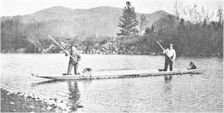The Canoe Maker
On the Pilchuck lived and worked part of `he year the Canoe-maker. He did not make canoes alone. Handling the big logs took more than one man. But he had a good eye for the best trees and for the shaping of the canoes. When a good tree had been selected, the fillers commenced their work. Their tools were chisel and hammer. Their best chisel was a tool about 8 or 10 inches long and one-half to two inches wide, made of bone or elkhorn, and called queahad. Striking the end of the handle with the hammer (skaat-scheed with long … Read more

